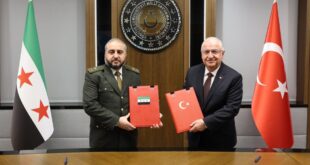BAQOUBA — Specialist Robert Mathews of the US army gets down on one knee between two hulking Bradley armoured fighting vehicles and prays — his cavalry platoon is heading into war-torn downtown Baqouba.
Mathews’ unit is heading into the bitterly divided Iraqi city to take its turn guarding an Iraqi police station and reimpose the government’s battered authority in an area rife with Sunni insurgents.
The short journey “outside the wire” from Camp Warhorse to a fortified police post dubbed “Station Earth” takes them on a dangerous route, and the platoon’s battalion has lost three soldiers in the previous six weeks.
At 11:00am as the men of First Platoon and the 1-12 cavalry make their preparations, some of their faces betray their fear.
Others display a chest-thumping bravado as they pump themselves up for the test ahead.
“I attract them. Yeah man, but I don’t give a shit! The guy who shoots at me, I just unload on them, and it’s ‘see you in another life baby’,” declares Sergeant Willie Thomas, a gunner in one of the Bradleys.
As the convoy rolls into the station its pockmarked facade bears testament to the fierceness of the conflict.
Insurgents attempted to throw the police out of Baqouba, but now the US has thrown its support into making sure the police prevail this time.
“We’re thumping them and we’re thumping them hard,” says Captain Chris Conley, a graduate of the renowned West Point military academy and company commander whose three platoons rotate through the frontline post on 72-hour rotations.
“We came back in the neighbourhood last week. They didn’t like it. They attacked us as soon as we got here. There were contacts everyday,” he says.
“They thought they were going to push us out, that we would give in and leave. But we’re staying. We’ve killed around 50 enemies,” he adds.
Conley says he spends as much of his time as possible with the platoon on duty, sleeping on rudimentary cots and eating field rations in an overcrowded building without electricity or running water.
The troops spend the afternoon on the roof behind sandbagged firing positions overlooking a Sunni district of the city described by Sergeant Andrew Benson as “Bad Man’s Land”.
As night falls, the temperature drops dramatically.
Then gunfire erupts in the darkness, echoing around the neighbourhood in front of the US position. At 8:00 pm Conley sends two Bradleys and three Humvee jeeps full of troops to investigate.
The gunner in one Bradley fires his 25mm cannon.
Through his night-vision sight he has seen incoming fire and gunmen running into a house. Eight Americans jump from a Humvee and give chase, but fall back when they spot a wire across a door.
Booby traps and roadside bombs are the biggest dangers for GIs in Iraq.
Twenty minutes later and the Bradley fires again, the heavy calibre shells from the turret gun ripping apart a man. When the Americans reach his body they find a Kalashnikov assault rifle lying nearby.
The soldiers burst into a nearby house and come upon a woman hugging two children and sobbing. There is no man in the house and, after a quick search, the troops head back into the street. Their radio crackles an order.
“We got to take a picture of the body.” — “What the hell for?” — “I didn’t say it was easy. Those are the orders.” The men turn the bloody body over and photograph it before moving on.
It’s now 25 minutes since the patrol left the police post and the GIs come upon a locked gate. No one answers when they knock, so the Bradley swings into the compound wall and knocks it down.
Inside a family is watching the movie “King Kong” on television.
The man of the house is searched and the 10-year-old son is taken to one side by “Shooter”, the platoon’s Iraqi interpreter.
“Where are the bad men?” he asks, but the boy says nothing.
“Kids are more truthful and they don’t like the violence around.
It’s a technique. The men usually don’t say anything. We don’t interrogate the women. Too sensitive,” explains Lieutenant Ben Dowell.
The men head back to sleep, tomorrow will be a busy day.
It’s 3:30 am and operation “Rabbit Hunter” starts early. A combined force of US and Iraqi personnel are going to encircle and search the Khatun district of Baqouba and seek out a bomb factory and a kidnap gang.
As the Bradleys deploy around the area one of them is hit by an improvised explosive device (IED), or roadside booby trap. No one is hurt, but the vehicle has to be withdrawn.
While the crew chiefs and gunners scan the surrounding area, the troops in the uncomfortable rear cabin doze amid a clutter of well-worn weapons and crates of high-energy drinks.
The mission is a success.
The US cavalry’s Iraqi comrades have arrested more than 40 suspects and liberated a teenage boy held hostage by the gang, so the soldiers head back to base and organise a duty roster for guarding the roof overnight.
One Bradley has to head back to base, however, at 2:00am, and one of the crewmen wearily breaks open a ration pack to sustain him on the way home.
“Don’t eat that f…… chicken patty. It’s bad luck,” shouts Sergeant Carlos Santillana. “Each time we eat some we get IED-ed or shot at. Come on, let’s get dead.”
 Eurasia Press & News
Eurasia Press & News



